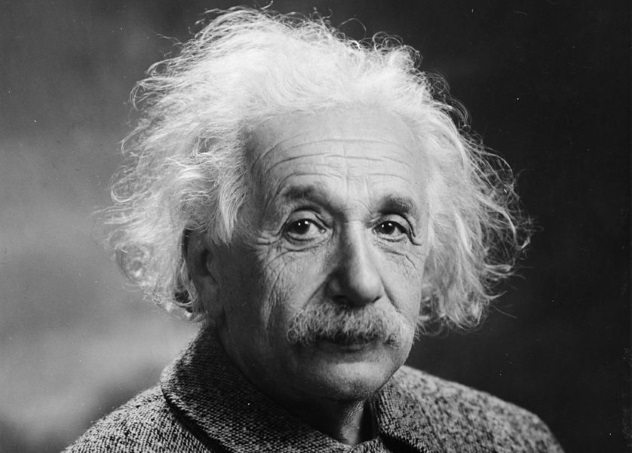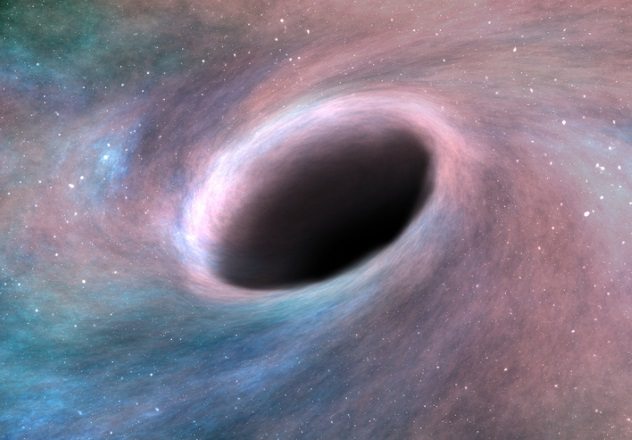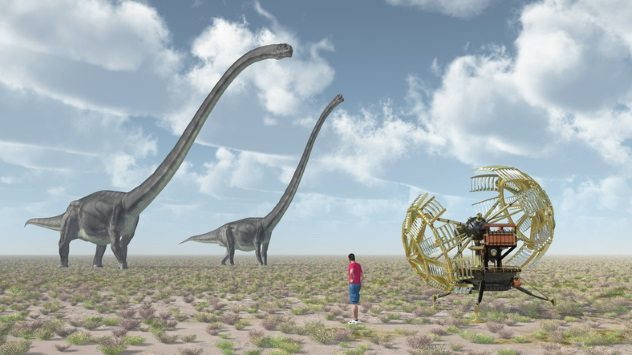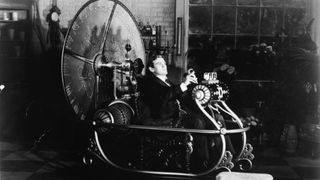10 Out-Of-This-Universe Ideas About Time Travel
Who Invented Television?
The way people watch television has changed dramatically since the medium first burst onto the scene in the 1940s and ‘50s and forever transformed American life. Decade after decade, TV technology has steadily advanced: Color arrived in the 1960s, followed by cable in the ‘70s, VCRs in the ‘80s and high-definition in the late ‘90s. In the 21st century, viewers are just as likely to watch shows on cell phones, laptops and tablets as on a TV set. Amazingly, however, all these technological changes were essentially just improvements on a basic system that has worked since the late 1930s—with roots reaching even further back than that.
Early TV Technology: Mechanical Spinning Discs
No single inventor deserves credit for the television. The idea was floating around long before the technology existed to make it happen, and many scientists and engineers made contributions that built on each other to eventually produce what we know as TV today.
Television’s origins can be traced to the 1830s and ‘40s, when Samuel F.B. Morse developed the telegraph, the system of sending messages (translated into beeping sounds) along wires. Another important step forward came in 1876 in the form of Alexander Graham Bell’s telephone, which allowed the human voice to travel through wires over long distances.
Both Bell and Thomas Edison speculated about the possibility of telephone-like devices that could transmit images as well as sounds. But it was a German researcher who took the next important step toward developing the technology that made television possible. In 1884, Paul Nipkow came up with a system of sending images through wires via spinning discs. He called it the electric telescope, but it was essentially an early form of mechanical television.
TV Goes Electronic With Cathode Ray Tubes
In the early 1900s, both Russian physicist Boris Rosing and Scottish engineer Alan Archibald Campbell-Swinton worked independently to improve on Nipkow’s system by replacing the spinning discs with cathode ray tubes, a technology developed earlier by German physicist Karl Braun. Swinton’s system, which placed cathode ray tubes inside the camera that sent a picture, as well as inside the receiver, was essentially the earliest all-electronic television system.
Russian-born engineer Vladimir Zworykin had worked as Rosing’s assistant before both of them emigrated following the Russian Revolution. In 1923, Zworykin was employed at the Pittsburgh-based manufacturing company Westinghouse when he applied for his first television patent, for the “Iconoscope,” which used cathode ray tubes to transmit images.
Meanwhile, Scottish engineer John Baird gave the world’s first demonstration of true television before 50 scientists in central London in 1927. With his new invention, Baird formed the Baird Television Development Company, and in 1928 it achieved the first transatlantic television transmission between London and New York and the first transmission to a ship in mid-Atlantic. Baird is also credited with giving the first demonstration of both color and stereoscopic television.
Recommended for you
Louisiana
Paris Commune of 1871
Why the War of 1812 Was a Turning Point for Native Americans
In 1929, Zworykin demonstrated his all-electronic television system at a convention of radio engineers. In the audience was David Sarnoff, an executive at Radio Corporation of America (RCA), the nation’s biggest communications company at the time. Born into a poor Jewish family in Minsk, Russia, Sarnoff had come to New York City as a child and began his career as a telegraph operator. He was actually on duty on the night of the Titanic disaster; although he likely didn’t—as he later claimed—coordinate distress messages sent to nearby ships, he did help disseminate the names of the survivors.
Utah Inventor Battles Giant Corporation

April 30, 1939, New York City: This is the scene viewed on the television receivers in the metropolitan area, as the National Broadcasting Company inaugurated the first regular television service to the American public telecasting the ceremonies marking the opening of the New York World’s Fair. Later, viewers heard and saw President Roosevelt proclaim the fair open.
Bettmann via Getty Images
Sarnoff was among the earliest to see that television, like radio, had enormous potential as a medium for entertainment as well as communication. Named president of RCA in 1930, he hired Zworykin to develop and improve television technology for the company. Meanwhile, an American inventor named Philo Farnsworth had been working on his own television system. Farnsworth, who grew up on a farm in Utah, reportedly came up with his big idea—a vacuum tube that could dissect images into lines, transmit those lines and turn them back into images—while still a teenager in chemistry class.
In 1927, at the age of 21, Farnsworth completed the prototype of the first working fully electronic TV system, based on this “image dissector.” He soon found himself embroiled in a long legal battle with RCA, which claimed Zworykin’s 1923 patent took priority over Farnsworth’s inventions. The U.S. Patent Office ruled in favor of Farnsworth in 1934 (helped in part by an old high school teacher, who had kept a key drawing by the young inventor), and Sarnoff was eventually forced to pay Farnsworth $1 million in licensing fees. Though viewed by many historians as the true father of television, Farnsworth never earned much more from his invention, and was dogged by patent appeal lawsuits from RCA. He later moved on to other fields of research, including nuclear fission, and died in debt in 1971.
Sarnoff, with his company’s marketing might, introduced the public to television in a big way at the World’s Fair in New York City in 1939. Under the umbrella of RCA’s broadcasting division, the National Broadcasting Company (NBC), Sarnoff broadcast the fair’s opening ceremonies, including a speech by President Franklin D. Roosevelt.
WATCH: Full episodes of ‘The Machines That Built America’ online now.
The Rise of a New Medium
By 1940, there were only a few hundred televisions in use in the United States. With radio still dominating the airwaves—more than 80 percent of American homes owned one at the time—TV use grew slowly over the course of the decade, and by the mid-1940s, the United States had 23 television stations (and counting). By 1949, a year after the debut of the hit variety show Texaco Star Theater, hosted by comedian Milton Berle, the nation boasted 1 million TV sets in use.
By the 1950s, television had truly entered the mainstream, with more than half of all American homes owning TV sets by 1955. As the number of consumers expanded, new stations were created and more programs broadcast, and by the end of that decade TV had replaced radio as the main source of home entertainment in the United States. During the 1960 presidential election, the young, handsome John F. Kennedy had a noticeable advantage over his less telegenic opponent, Richard M. Nixon in televised debates, and his victory that fall would bring home for many Americans the transformative impact of the medium.
10 Out-Of-This-Universe Ideas About Time Travel
Time travel captivates the imaginations of many. We see time travel in plenty of movies, such as the Terminator and Back to the Future franchises. There are even those among us who believe certain people to be time travelers.
As of today, we have no proof that there are, in fact, time travelers among us. All the time travelers we know are from the silver screen. What we do have today are theories about how time travel may be possible and how it would work.
10 Einstein’s Theory Of General Relativity

The first theory on this list is Einstein’s theory of general relativity. [1] This theory helped physicists theorize about how time travel could exist. The theory of general relativity discusses how objects in space create a distortion on the space-time continuum, which we know as gravity. Now, gravity does not lead to time travel, but it has created phenomena (both known to exist and theorized) that could lead to time travel.
Physicists have used this theory to come up with and explain wormholes and black holes. We will discuss both of these phenomena further in this list. Both of these “holes” are theorized to be ways that time travel could exist. Without Einstein’s theory of general relativity, physicists would not have been able to connect wormholes and black holes to potential time travel.
9 Wormholes

The second theory that we will look at is one of a lot of hope but no real proof. Wormholes have not been proven to exist. No wormhole has ever been found in space, but scientists still think they may be there. Even though no wormholes have ever been identified, physicists believe they may exist by looking at Einstein’s theory of relativity. [2] If wormholes do indeed exist, they may be the answer to traveling through time.
It is theorized that wormholes are shortcuts through space and time. This could mean if someone entered a wormhole, they could travel to another part of the universe or through time. Another issue with this theory is that if wormholes did exist, they would be so small that a person couldn’t even fit into them, this would make it impossible, then, for a spacecraft to fly into one. Although there is no proof that wormholes exist, this theory is one of the leaders to why time travel may one day be possible.
8 Black Holes

Black Holes are areas in the universe with such strong gravity that not even light escapes. This could have been caused by a supernova or possibly the collision of stars. Physicists believe that anything that goes into a black hole would never escape. Their gravity is so strong that even time gets slowed down. [3] For time travel to work with a black hole, you would need to orbit around it and not get sucked into its event horizon.
Since the gravity of the black hole is so great, the time it would take a spaceship to orbit around it would be vastly different than time on Earth. Years would fly by back home. This means that you would be vastly younger than someone the same age as you when you came back to Earth. This, obviously, has never been attempted, but in the future, it may be a way for someone to time travel.
7 Cosmic Strings

Cosmic strings are narrow tubes of energy that stretch across the universe. They are thought to be remnants of early cosmos and are theorized to contain a huge amount of mass. Thus, they could warp space-time around them. Scientists also believe that these strings are either found in loops or in straight, infinite lines. [4] If these strings are indeed in lines around the universe, there could be a possibility that they could create time travel.
Scientists believe that if two cosmic strings ran parallel to one another, and were close enough together, they could bend space-time. Since this would be such a huge bend, it could make time travel possible. This theory would work similarly to the black hole theory of time travel.
6 Time Machines

We have seen time machines used in countless movies, and as children, some of us even imagined that one day, we would get to go inside a time machine and travel anywhere in the past or the future. Even though time machines do not exist, at least yet, the theories about how a time machine could allow someone to travel through time are fascinating.
Scientists believe that for a time machine to work, matter with negative energy density would be required. Such matter would do weird things like move in the opposite direction of regular matter when pushed. The issue is that if this matter did exist, there wouldn’t be enough of it for a time machine. [5] There are more theories out there on how a time machine could work, but this one is the most prominent.
5 Traveling Faster Than the Speed Of Light

This theory comes from Superman himself, sort of. In Superman (1978), Superman turns back time by flying so fast that the Earth’s rotation reverses. Of course, that’s ridiculous, so some have floated the explanation that Superman actually went back in time by traveling faster than the speed of light. How would that work? The speed of light is the fastest anything can go, as far as we know. If something travels faster than the speed of light, the time for the object to reach its destination would come out to a negative number. Thus, theoretically, it would travel back in time. [6]
The huge flaw in this theory is that nothing can go faster than the speed of light. Also, scientists researching this concept have found that there would have to be a variety of factors being met for this to work. Just traveling faster than the speed of light would not meet all of the factors necessary to time travel.
4 Tipler Cylinder

This theory would be nearly impossible to attempt, but it makes for a very interesting idea about just how much mass we would need for time travel. For this theory, we would need to find a piece of matter that is ten times the mass of the Sun. It would then need to be rolled into a very dense, long, and thin cylinder. In our universe, we can find objects ten times the mass of the Sun, but it would be quite difficult to roll one into a long cylinder.
As if this first part wasn’t hard enough, the cylinder would also need to be spinning at as many as a few billion revolutions per minute. If all of these factors were just right, a spaceship following a perfectly precise spiral route around the cylinder could enter a closed time-like curve. This would then allow the spaceship to travel through time. [7]
A beginner’s guide to time travel
Learn exactly how Einstein’s theory of relativity works, and discover how there’s nothing in science that says time travel is impossible.

Actor Rod Taylor tests his time machine in a still from the film ‘The Time Machine’, directed by George Pal, 1960. (Image credit: Hulton Archive / Staff / Getty Images)
Everyone can travel in time (opens in new tab) . You do it whether you want to or not, at a steady rate of one second per second. You may think there’s no similarity to traveling in one of the three spatial dimensions at, say, one foot per second. But according to Einstein (opens in new tab) ‘s theory of relativity (opens in new tab) , we live in a four-dimensional continuum — space-time — in which space and time are interchangeable.
Einstein found that the faster you move through space, the slower you move through time — you age more slowly, in other words. One of the key ideas in relativity is that nothing can travel faster than the speed of light (opens in new tab) — about 186,000 miles per second (300,000 kilometers per second), or one light-year per year). But you can get very close to it. If a spaceship were to fly at 99% of the speed of light, you’d see it travel a light-year of distance in just over a year of time.
That’s obvious enough, but now comes the weird part. For astronauts onboard that spaceship, the journey would take a mere seven weeks. It’s a consequence of relativity called time dilation, and in effect, it means the astronauts have jumped about 10 months into the future.
Traveling at high speed isn’t the only way to produce time dilation. Einstein showed that gravitational fields produce a similar effect — even the relatively weak field here on the surface of Earth (opens in new tab) . We don’t notice it, because we spend all our lives here, but more than 12,400 miles (20,000 kilometers) higher up gravity is measurably weaker— and time passes more quickly, by about 45 microseconds per day. That’s more significant than you might think, because it’s the altitude at which GPS satellites (opens in new tab) orbit Earth, and their clocks need to be precisely synchronized with ground-based ones for the system to work properly.
The satellites have to compensate for time dilation effects due both to their higher altitude and their faster speed. So whenever you use the GPS feature on your smartphone or your car’s satnav, there’s a tiny element of time travel involved. You and the satellites are traveling into the future at very slightly different rates.
But for more dramatic effects, we need to look at much stronger gravitational fields, such as those around black holes (opens in new tab) , which can distort space-time (opens in new tab) so much that it folds back on itself. The result is a so-called wormhole, a concept that’s familiar from sci-fi movies, but actually originates in Einstein’s theory of relativity. In effect, a wormhole (opens in new tab) is a shortcut from one point in space-time to another. You enter one black hole, and emerge from another one somewhere else. Unfortunately, it’s not as practical a means of transport as Hollywood makes it look. That’s because the black hole’s gravity would tear you to pieces as you approached it, but it really is possible in theory. And because we’re talking about space-time, not just space, the wormhole’s exit could be at an earlier time than its entrance; that means you would end up in the past rather than the future.
Trajectories in space-time that loop back into the past are given the technical name “closed timelike curves.” If you search through serious academic journals, you’ll find plenty of references to them — far more than you’ll find to “time travel.” But in effect, that’s exactly what closed timelike curves are all about — time travel
This article is brought to you by How It Works.
How It Works is the action-packed magazine that’s bursting with exciting information about the latest advances in science and technology, featuring everything you need to know about how the world around you — and the universe — works.
There’s another way to produce a closed timelike curve that doesn’t involve anything quite so exotic as a black hole or wormhole: You just need a simple rotating cylinder made of super-dense material. This so-called Tipler cylinder is the closest that real-world physics can get to an actual, genuine time machine. But it will likely never be built in the real world, so like a wormhole, it’s more of an academic curiosity than a viable engineering design.
Yet as far-fetched as these things are in practical terms, there’s no fundamental scientific reason — that we currently know of — that says they are impossible. That’s a thought-provoking situation, because as the physicist Michio Kaku is fond of saying, “Everything not forbidden is compulsory” (borrowed from T.H. White’s novel, “The Once And Future King”). He doesn’t mean time travel has to happen everywhere all the time, but Kaku is suggesting that the universe is so vast it ought to happen somewhere at least occasionally. Maybe some super-advanced civilization in another galaxy knows how to build a working time machine, or perhaps closed timelike curves can even occur naturally under certain rare conditions.
An artist’s impression of a pair of neutron stars – a Tipler cylinder requires at least ten. (Image credit: NASA)
This raises problems of a different kind — not in science or engineering, but in basic logic. If time travel is allowed by the laws of physics, then it’s possible to envision a whole range of paradoxical scenarios (opens in new tab) . Some of these appear so illogical that it’s difficult to imagine that they could ever occur. But if they can’t, what’s stopping them?
Thoughts like these prompted Stephen Hawking (opens in new tab) , who was always skeptical about the idea of time travel into the past, to come up with his “chronology protection conjecture” — the notion that some as-yet-unknown law of physics prevents closed timelike curves from happening. But that conjecture is only an educated guess, and until it is supported by hard evidence, we can come to only one conclusion: Time travel is possible.
A party for time travelers
Hawking was skeptical about the feasibility of time travel into the past, not because he had disproved it, but because he was bothered by the logical paradoxes it created. In his chronology protection conjecture, he surmised that physicists would eventually discover a flaw in the theory of closed timelike curves that made them impossible.
In 2009, he came up with an amusing way to test this conjecture. Hawking held a champagne party (shown in his Discovery Channel program), but he only advertised it after it had happened. His reasoning was that, if time machines eventually become practical, someone in the future might read about the party and travel back to attend it. But no one did — Hawking sat through the whole evening on his own. This doesn’t prove time travel is impossible, but it does suggest that it never becomes a commonplace occurrence here on Earth.
The arrow of time
One of the distinctive things about time is that it has a direction — from past to future. A cup of hot coffee left at room temperature always cools down; it never heats up. Your cellphone loses battery charge when you use it; it never gains charge. These are examples of entropy (opens in new tab) , essentially a measure of the amount of “useless” as opposed to “useful” energy. The entropy of a closed system always increases, and it’s the key factor determining the arrow of time.
It turns out that entropy is the only thing that makes a distinction between past and future. In other branches of physics, like relativity or quantum theory, time doesn’t have a preferred direction. No one knows where time’s arrow comes from. It may be that it only applies to large, complex systems, in which case subatomic particles may not experience the arrow of time.
Time travel paradox
If it’s possible to travel back into the past — even theoretically — it raises a number of brain-twisting paradoxes — such as the grandfather paradox — that even scientists and philosophers find extremely perplexing.
Killing Hitler
A time traveler might decide to go back and kill him in his infancy. If they succeeded, future history books wouldn’t even mention Hitler — so what motivation would the time traveler have for going back in time and killing him?
Killing your grandfather
Instead of killing a young Hitler, you might, by accident, kill one of your own ancestors when they were very young. But then you would never be born, so you couldn’t travel back in time to kill them, so you would be born after all, and so on …
A closed loop
Suppose the plans for a time machine suddenly appear from thin air on your desk. You spend a few days building it, then use it to send the plans back to your earlier self. But where did those plans originate? Nowhere — they are just looping round and round in time.
Source https://www.history.com/news/who-invented-television
Source https://listverse.com/2018/04/11/10-out-of-this-universe-ideas-about-time-travel/
Source https://www.livescience.com/time-travel-beginners-guide.html